SUMMARY
This is AI generated summarization, which may have errors. For context, always refer to the full article.
EASTERN SAMAR, Philippines – “Good morning, visitor!”
The children of Barangay Sta Fe in General McArthur greeted – in chorus, standing straight – guests from non-governmental organizations (NGOs).
It was almost noon and all 8 children were getting hungry. Five of them are preschoolers, 3 are 1st graders, but they are all classmates.
Sta Fe is home to 17 schoolchildren, from kindergarten up to Grade 3. Classes are divided into two sessions: morning for preschoolers and 1st graders; afternoon for 2nd and 3rd graders.
“Children are mixed, joint classes because there’s only one teacher – me,” said Violeta Orpin or “Ma’am Letlet.”
“While I teach preschoolers, I give 1st graders seat work. Then vice-versa,” Orpin explained. “They have different lessons, sometimes, same.”
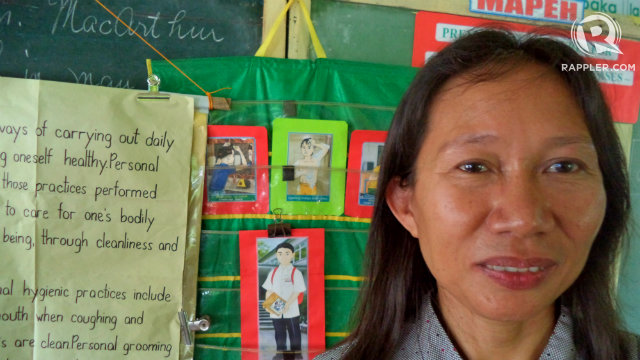
She teaches all subjects.
Orpin has been teaching for 8 years, but it is only her first month in Sta Fe. “Teachers start from the mountains, then transferred further down,” she quipped. Letlet began teaching in Barangay Magsaysay, located in a mountainous area, then was assigned to two other barangays before finally landing in Sta Fe.
Most textbooks are in english, but she teaches them in Waray. “Translating is hard. I’m worried if I translated it right,” she admitted.
“Itong mga teaching manual, pina-Xerox lang. Inutang pa ng naunang teacher. Delayed kasi school budget (These teaching manuals are only photocopied. The teacher before me only got these through debts because the school budget is delayed).”
Orpin has two children of her own, both college students in her hometown Guiuan. “My salary goes to their studies. It’s not enough, so I have many debts,” the solo mother said, adding, “P19,000 per month salary, pero maraming kaltas. Kaunti natitira (But my salary has lots of deductions. Little is left).”
 Letlet rounded up the children and instructed them to wash their hands.
Letlet rounded up the children and instructed them to wash their hands.
After super typhoon Yolanda (Haiyan), NGOs visited barangays to teach residents about proper hygiene and sanitation.
Lunch time. Not everyone, however, had something to eat. (READ: Learning on an empty stomach)
Recess?
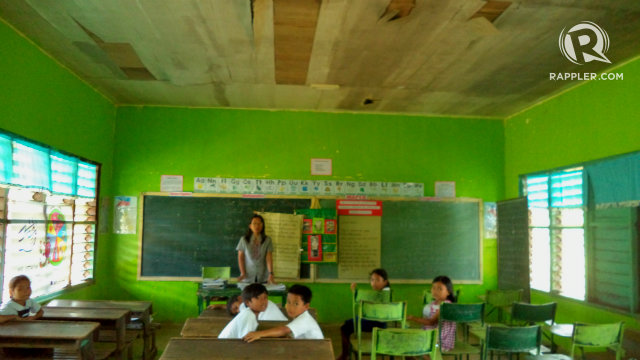
Fortunately, Yolanda did not destroy Orpin’s school but only damaged the ceiling. (READ: Yolanda, schools)
Outside the school, however, the rest of Sta Fe was beaten 
“Most children go home to eat, some eat vegetables since their parents are farmers. But others eat junk food like chips and ice candy,” Orpin observed.
Ruffa is 8 years old, a 3rd grader. Some of her classmates are older by a few years; others a bit younger.
“Gusto ko maging teacher parang si Ma’am Letlet (I want to be a teacher like Ma’am Letlet),” she said. “English teacher.”
For breakfast, she usually eats biscuits and “Meteor Garden,” a popular junk food among kids. “Minsan kanin at hotdog o manok o asukal. Minsan wala (Sometimes rice and hotdog or chicken or sugar. Sometimes none),” Ruffa said.
“O kaya kanin at toyo’t asin (Or rice with soy sauce and salt)!” her classmate added. (
What about recess? “Kanin at tubig (Rice and water).”
“If I only had funds, I’d make a feeding program,” Orpin said. “Even before class dismissal, they already want to go home. They’re hungry.” She added that the supplementary feeding program (SFP) of the Department of Social Welfare and Development (DSWD) has not yet reached Sta Fe.
“Probably because the student population here is very small,” said Esther Magdayo of Action Against Hunger (ACF), the humanitarian organization supporting the school’s hygiene program.
Ruffa will leave Sta Fe next year. “There’s no Grade 4 onwards in Sta Fe. Kids go to a different barangay to continue schooling,” Orpin said.
Next year, Ruffa will have to walk at least 30 minutes to get to class. She might need a heavier breakfast then.
Study hard
After “graduating” from Sta Fe, most children move on to Camcueves elementary school, which currently has 81 students but only 3 teachers and one daycare worker.
Unlike Sta Fe, Camcueves conducts its DSWD-sponsored SFP. “But it only began on November 3,” said Marietta Bagunas, barangay kagawad and president of the school’s Parent-Teacher Association.
After Yolanda took the school down, children began studying in tents provided by UNICEF. In November, ACF plans to start the school’s reconstruction.

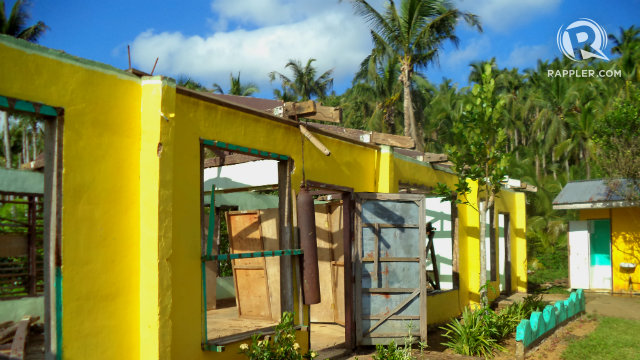


“Another problem is children lack books,” Bagunas said.
For high school, students must move again to other barangays like Poblacion. “They have to stay in boarding houses or relatives because it’s too far. They go home weekends only. It’s expensive, like college,” Bagunas said.
The long walk home lasts for 2 hours, but if students have money, a tricycle ride can save them time.
Making it work
Cam Cuevas also lost most of its coconut trees.
 “Now fathers work as delivery men. They get the wood from the mountains and ride carabaos to deliver it to other barangays like Sta Fe,” Bagunas explained. “Earning P500 a day, but not everyday.”
“Now fathers work as delivery men. They get the wood from the mountains and ride carabaos to deliver it to other barangays like Sta Fe,” Bagunas explained. “Earning P500 a day, but not everyday.”
Most men do not own the carabao themselves, so they have to pay rental fees.
Meanwhile, women are mostly housewives, while some run sari-sari stories or cook and sell pancit (noodles) or kakanin (rice cake). “We also plant vegetables, but we don’t sell them, we just share it among us neighbors,” Bagunas added. “Whoever harvests, shares.”
Back in Sta Fe, Orpin prepares for her afternoon class. It was quite hot and there were no electric fans.
“Mahirap magturo. Pero ‘pag nakikinig ang bata, natutuwa ako,” Letlet said. “Sana sa susunod, hindi na halo-halo mga bata. Sana (It’s hard to teach. But when children listen, I feel happy. I hope next time, the children won’t be mixed. I hope).”
The afternoon class was about to start.
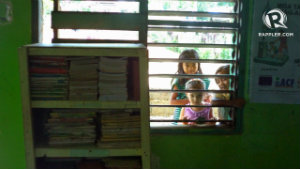
Some had lunch, others had not. Some could not wait to learn, others could not wait for dinner. — Rappler.com
For Rappler’s full coverage of the 1st anniversary of Super Typhoon Yolanda (Haiyan), go to this page.
Add a comment
How does this make you feel?
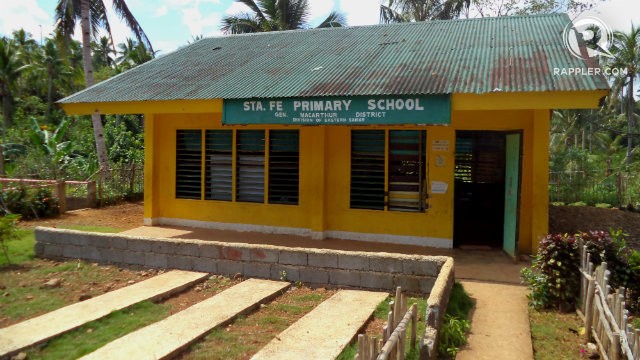
There are no comments yet. Add your comment to start the conversation.